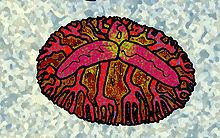Kingdom Animalia Phylum Trilobozoa Fedonkin, 1985 | Genus Anfesta Fedonkin, 1984 Rank Species | |
 | ||
Family Albumaresidae Fedonkin, 1985 Similar Albumares, Trilobozoa, Rugoconites, Vaveliksia, Onega stepanovi | ||
the evolution of life anfesta stankovskii
Anfesta stankovskii is a tri-radially symmetrical fossil animal that lived in the late Ediacaran (Vendian) seafloor. It is a member of the extinct group Trilobozoa.
Contents
- the evolution of life anfesta stankovskii
- Etymology
- Occurrence
- Description
- Reconstruction and affinity
- References
Etymology
The generic and specific names of the Anfesta stankovskii honour the Arkhangel'sk geologist Anatoliy F. Stankovskii.
Occurrence
Fossils of Anfesta stankovskii are known from deposits of the Verkhovka and Yorga formations on the Karakhta River in Onega Peninsula and Zimnii Bereg (Winter Coast) of the White Sea, Arkhangelsk Region, Russia.
Description
Anfesta fossils are preserved as low negative impressions on the lower surfaces of sandstone beds. The fossil has a round, three-lobed form bounded by a linear outer margin. Its surface is covered by dendritic furrows that branch out from three radial oval ridges in the center to the outer margin of the fossil. The lobes are regular in form, and are not twisted as in Albumares and Tribrachidium.
The diameters of known specimens vary from 5 to 18 millimeteres.
Reconstruction and affinity
Anfesta was originally described by Mikhail Fedonkin as a free-swimming scyphozoa-like medusa. The branched furrows on the fossil were interpreted as imprints of a system of internal radial canals, and the three oval ridges as imprints of gonads.
A year later, Fedonkin appointed such fossil animals as Anfesta, Albumares and Tribrachidium to the separate group Trilobozoa, populated by three-lobed, radially symmetric, coelenterate-grade animals that only superficially resemble cnidarians. Originally, Trilobozoa was established as a class within the phylum Coelenterata, but since Coelenterata was divided into separate phyla - Cnidaria and Ctenophora - the Trilobozoa have been transferred to rank of phylum.
According to the latest research, Anfesta was a soft-bodied benthic organism that temporarily attached (but did not adhere) to the substrate of its habitat (microbial mats). This fossil is an imprint of the upper side of the animal body, with some elements of its external and internal anatomy visible to the naked eye. The branched furrows on the fossil are imprints of radial grooves on the animal's surface, while the three central ridges are imprints of cavities within the body. Presumably, this system of grooves and cavities could be related to the collection and digestion of food particles.
